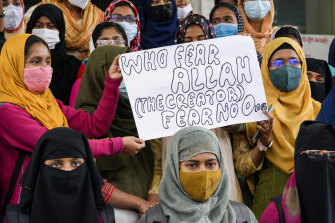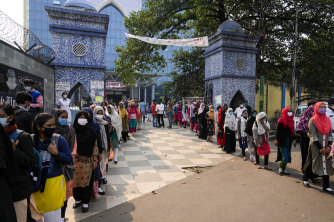Bengaluru: A request by a group of high school girls to wear the hijab in class has snowballed into dulling protests between Hindu and Muslim students in India, deepening religious polarisation as regional elections approach.
Debate over the hijab in schools took off last month after students at a pre-university college in Karnataka state’s Udupi district began protesting against a rule barring them from wearing the Muslim head covering in classrooms.
In late January, the girls petitioned the state’s high court, challenging the restrictions. But protests quickly spread across the state, as more educational institutions began banning Muslim students from wearing the hijab. Hindu activists have staged counterprotests, demanding that the saffron shawl – a Hindu religious symbol – be allowed in schools.
The protests began in Karnataka but have spread across India and into Pakistan. Credit:AP
The opposing movements have deepened festering religious polarisation in the region and prompted the state to temporarily close secondary schools this week. On Tuesday, protests turned violent, with reports emerging from some cities of stone-throwing and arson, according to the BBC.
Muskan Khan, a student in the city of Mandya in Karnataka state who wears the headscarf, became the face of resistance to the hijab bans after a video of her went viral this week.
The clip showed Khan, 19, pumping her fist and shouting “Allahu akbar” (“God is great”) at a group of men who were heckling her as she entered her college. The men wore saffron scarves and chanted “Jai Shri Ram” – “Victory to Lord Ram,” a call popular among Hindu nationalist groups.
“All that I want is to stand by my rights and education,” Khan told the BBC after the incident.
Demonstrations have spread to India’s capital, Delhi, and cities including Kolkata, where students blocked roads in protest of hijab prohibitions in Karnataka. On Thursday, women in two cities in neighbouring Pakistan protested in solidarity.
Unlike some European countries that have fiercely debated the right to wear the veil, there are no nationwide restrictions on wearing the hijab in public places in India. But a growing number of schools and officials in Karnataka have begun saying that religious garments should not be worn in the classroom.
“Government is very firm that the school is not a platform to practice dharma [religion],” Karnataka education minister BC Nagesh told CNN affiliate CNN News-18.
Officials have also said saffron scarves are forbidden in class.
A student identified as Al-Rifa told the Indian news publication Scroll.in that her school in Karnataka was “forcing us to choose between studies and the hijab” and that female Muslim students feel unsafe on campus.
“I was made to realise that I am a Muslim. Someone who dresses differently,” she said. “I have never thought about these things before.”
The protest movement got a high-profile endorsement on Tuesday, when Nobel Peace laureate Malala Yousafzai, a Pakistani advocate for girls’ education who also wears a headscarf, condemned the hijab ban on Twitter.
“Refusing to let girls go to school in their hijabs is horrifying,” she wrote. “Objectification of women persists – for wearing less or more. Indian leaders must stop the marginalisation of Muslim women.”
The All India President of the Students’ Federation of India also criticised the ban, writing on Twitter that the hijab was being “cited as reason to deny Muslim women’s right to education.”
Human Rights Watch also decried the ban as discriminatory.
The rival protests between hijab-wearing Muslim students and saffron scarf-wearing Hindu students has deepened communal tensions in the region.
Karnataka authorities closed high schools and colleges for three days this week as the threat of violence mounted. Chief Minister Basavaraj Bommai announced on Thursday that classes would resume on Monday. The state’s high court had ordered the government to reopen schools but prevent students from wearing any religious dress until it delivers a verdict on petitions seeking to overturn the hijab ban.
Muslims make up about 13 per cent of the population in Karnataka, which is a stronghold of Prime Minister Narendra Modi’s Hindu right-wing BJP party. Since coming to power in 2019, the regional government has passed orders tightening the slaughter of beef in the state and introduced a controversial bill that would make it more difficult for interfaith couples to marry and for people to convert to Islam or Christianity.
The hijab ban is the latest example of the polarising identity politics as many states in India go to the polls. Here, girls in Kolkata protests in support of students in Karnataka banned from wearing the hijab in class. Credit:AP
Five other states in India head to the polls to kick off a high-stakes election season and identity politics are taking centre stage.
Experts say the BJP has sought to benefit from polarisation between Hindus and Muslims. Across India, anti-Muslim hate speech is on the rise. And police have taken little action against those involved in events where crowds pledged to kill Muslims.
Aliya Assadi, 17, who has worn the hijab since she was 7 years old, said she and her classmates sat in the hallway of their all-girls secondary school in Karnataka all day after they were barred from attending classes.
Initially, their Hindu classmates were supportive. But that soon changed, Assadi said.
“It breaks my heart to see my classmates and friends change so fast and speak on communal lines. It simply makes my cry,” she said. “I know they are not bad people. I know they are being used by politicians. But still, it is painful to see your friends endorse hatred.”
The Washington Post
Most Viewed in World
From our partners
Source: Read Full Article


